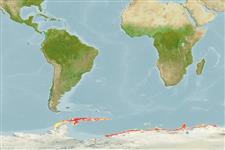Preferred temperature (Ref.
123201): -0.3 - 0.8, mean 0.4 °C (based on 69 cells).
Phylogenetic diversity index (Ref.
82804): PD
50 = 1.0000 [Uniqueness, from 0.5 = low to 2.0 = high].
Bayesian length-weight: a=0.00123 (0.00076 - 0.00199), b=3.48 (3.34 - 3.62), in cm total length, based on LWR estimates for this species & (Sub)family-body (Ref.
93245).
Niveau trophique (Ref.
69278): 3.8 ±0.57 se; based on food items.
Résilience (Ref.
120179): Milieu, temps minimum de doublement de population : 1,4 à 4,4 années (Fec = 15,612).
Fishing Vulnerability (Ref.
59153): Moderate vulnerability (44 of 100).
Climate Vulnerability (Ref.
125649): High to very high vulnerability (73 of 100).
Nutrients (Ref.
124155): Calcium = 24 [14, 53] mg/100g; Iron = 0.441 [0.186, 0.897] mg/100g; Protein = 17.4 [15.7, 19.1] %; Omega3 = 0.273 [0.141, 0.520] g/100g; Selenium = 26.2 [10.5, 58.0] μg/100g; VitaminA = 12.9 [2.8, 61.1] μg/100g; Zinc = 0.342 [0.222, 0.522] mg/100g (wet weight);
